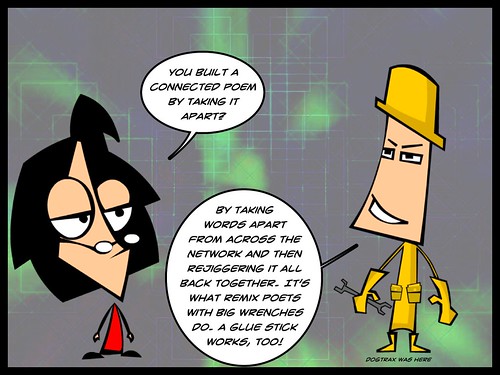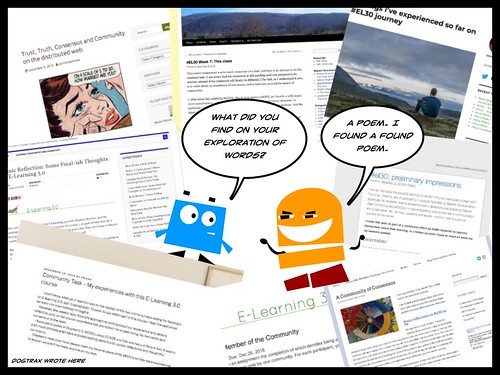A poem, then, that emerges from a blog post of a friend. This is where this poem began … consider these words as my process notes, my thinking out loud about my compositional intentions, a trail through the act of composing, as best as I can recall it.
Anna inadvertently, perhaps, starts the kernel of this poem off with a blog post — Nothing to Write Home About — as part of her effort to write every day, noting that ‘writing’ is different than ‘blogging’ and she has been busy, with a newborn baby. She’s been writing but not necessarily for the world. For herself. Maybe for her baby. Her musings strike a chord.
New found appreciation of warped time…..yes I know that one! Thanks for the fragments #Modigiwri Thinking @katevideo might like this post.
— Wendy Taleo (@wentale) December 28, 2018
Like a tweet comment from Wendy after she read Anna’s post, I am thinking of how Anna re-frames time in her piece, and I suddenly remember those nights with a newborn in my arms, snuggled in the deep hours of the morning. The weary mind but the full heart of the connection. A memory of me, new dad in the night, with my firstborn son in my arms, looking through the window at a deer slowly walking down the street, so quiet, so peaceful, and the magic of that moment comes to mind.
One line of Anna’s piece resonates with me, and as I turn it over in my mind, a poem emerges. So, I write it for her, on the spot and in the moment, as a comment to her blog post, and I leave the poem there for her, another trail of words in an ongoing conversation around digital writing. She’ll find it when she wakes and has a moment to look, I think.
This is what I write, with her own words leading the poem:
“I’ve never realized how long the night is …”
There is a quiet, a humming
of the hours, the slow unfolding
of stars, places in the mind where
one goes to remember how every
minute moves at its own pace, the
clicking of the clock an illusion
constructed out of some madman’s
desire to untangle time, knowledge
we know now to be irrelevant, when
now we know the only way
to measure the night is
through the slow breathing
of a baby in our arms
Then I realize, there might yet be more done with this poem for Anna. Our discussions as a group around writing digitally often have us considering media and mediums for expression, and poetry opens up all sorts of corridors, does it not?
I pull the words of the poem forward, from the screen and into Lumen5, which is an online digital storytelling tool, and I begin the harder work of representing the words of the poem in visual and with music.
While Lumen5 auto-fills pages with images, I find they don’t work for me, they are not deep-sky-night-sky-slow-time enough for my purposes, so I dig down, deeper, searching for how to represent the poem’s pieces, bit by bit, phrase by phrase, idea by idea. The poem’s visuals should represent the night, but also, the coming dawn. The images should tell the story of time, not clock-time but parent/baby-time.
I haggle with myself endlessly as I do this — does this work? Does it not? Why? Why not? Where does one line of a phrase end and another begin? What am I trying to say here? Does this image complement or contradict that meaning?
I conduct this internal argument — the writer of me engaged with the audience of me — rather automatically now. I wonder if experience with digital tools makes this compositional work easier or harder? Am I more of a critic of my choices or is my experience allowing to narrow decisions? I am only now, later, here in the writing of this that you read, pausing, to think about what I was thinking. I’m writing it down to remember it.
My search for the poem’s underlying music beneath the chosen images and text seems even more difficult. I want an open musical piece, something to represent the big sky wondering of a parent and baby in the quiet night, the near-sleep dreaming and wonder of it all. I try out more than a dozen songs — auditioning them for the poem, asking the music to bring its best bits forward — and finally find one song that has both intimacy and grandeur. Or enough of both for me to live with.
Side note of thinking: what if I had chosen the music first and images, second? Would that have made the poem’s digital presence different? Would the music have guided my decisions in visual choices in ways different than doing it in silence, knowing music would be the last piece? How did the decisions I made about visuals impact the decision I made about music? Interesting.
I choose the music, create the file in Lumen5, then download it and then upload the new version of the poem, sharing the video poem via Twitter in the morning through the #MoDigiWri hashtag, and I wonder if Anna will see it. I hope she sees it. Others make nice comments but Anna is my audience, and when she makes mention of the poem later in the day, I smile and feel satisfaction and joy at the gift of poetry.
Absolutely stunning poem. Brought a tear to my eye. I want to frame it, @dogtrax. Thank you. https://t.co/bw4x2rYmZp
— anna smith (@anna_phd) December 28, 2018
What we do with words matters, right?
Peace (into the long mornings and nights),
Kevin





